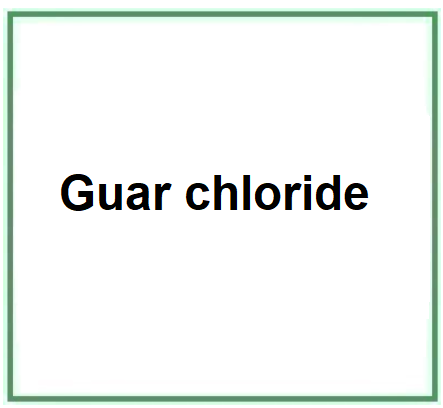Guar chloride is a naturally occurring product derived from the guar plant (Cyamopsis tetragonolobus) and contains a guar-derived structure and chloride ions.
The name defines the structure of the molecule
- "Guar" This part of the name indicates that the molecule is derived from guar, a leguminous plant. Guar is often used to produce guar gum, a polysaccharide that has gelling and stabilizing properties.
- "chloride." Indicates the presence of chloride ions in the molecule.
Description of the raw materials used in production and their functions:
- Guar Gum. A natural gum obtained from guar seeds. It's used as a thickening and stabilizing agent in many industrial applications.
- Cationic agents. These reagents are used to introduce cationic groups onto the guar structure, thus enhancing its properties.
Step-by-step industrial synthesis:
- Guar gum is dispersed in water to form a solution.
- The guar solution is treated with cationic agents (like 3-chloropropane-1,2-diol chloride) to introduce cationic groups onto the guar structure.
- The product is then purified to remove any unreacted reagents and impurities.
- The cationic guar is then dried and powdered for further use.
What it is for and where
Cosmetics
Hair conditioning agent. A significant number of ingredients with specific and targeted purposes may co-exist in hair shampoo formulations: cleansers, conditioners, thickeners, matting agents, sequestering agents, fragrances, preservatives, special additives. However, the indispensable ingredients are the cleansers and conditioners as they are necessary and sufficient for hair cleansing and manageability. The others act as commercial and non-essential auxiliaries such as: appearance, fragrance, colouring, etc. Hair conditioning agents have the task of increasing shine, manageability and volume, and reducing static electricity, especially after treatments such as colouring, ironing, waving, drying and brushing. They are, in practice, dispersants that may contain cationic surfactants, thickeners, emollients, polymers. The typology of hair conditioning agents includes: intensive conditioners, instant conditioners, thickening conditioners, drying conditioners. They can perform their task generally accompanied by other different ingredients.
Commercial Applications.
Cosmetics and Skin Care. Guar derivatives, such as guar hydroxypropyltrimonium chloride, are often used in cosmetic products for their conditioning properties. They help give a smooth and silky feel to hair and skin.
Hair Products. In particular, they can be found in shampoos and conditioners where they help improve combability and reduce frizz.
Pharmaceuticals. Some guar derivatives can be used as binding or stabilizing agents in pharmaceutical formulations.
Food Industry. Guar derivatives are used as thickeners and stabilizers in various food products to improve their texture.
![]() Guar chloride
Guar chloride 

